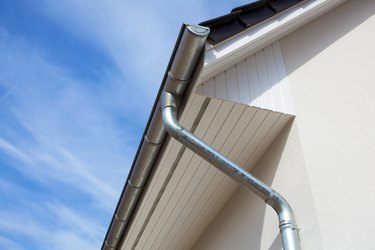
Galvanized steel shouldn't rust, but sometimes the galvanization wears off and allows the metal to rust. Normally, the zinc that's used to galvanize steel corrodes instead of the actual metal to prevent rust. When the zinc is all gone, this is when real rust sets in. You can remove rust from galvanized steel, but you'll need to repair the area that is rusted to prevent the rust from simply returning when the metal is again exposed to moisture.
What Is Galvanized Steel?
Video of the Day
Galvanized steel features a protective layer of zinc, often achieved through hot-dip galvanizing with the metal being submerged in zinc. The purpose is to keep the metal from rusting. Some metals are zinc plated, also referred to as electro-galvanizing, which uses a current of electricity to apply a thin layer of zinc over the metal. This method typically doesn't provide as much rust protection since the zinc layer is much thinner.
Video of the Day
Things You'll Need
Cleaning rags
Liquid detergent
Vinegar
Zinc-rich paint or cold galvanizing spray
How to Remove Rust From Galvanized Steel
Step 1: Clean the Galvanized Steel
Wipe down small pieces of steel using cleaning rags with three drops of liquid detergent to remove dirt, dust, grime, and sometimes large chunks of rust. Larger items can be pressure-washed or hosed down. The point of cleaning the galvanized steel is simply to remove grime so that you can target rusted areas more specifically.
Step 2: Use a Wire Brush to Remove Rust
Scrape off large areas of rust with the wire brush. Use firm pressure and a back-and-forth motion to remove rust from the metal. Dipping the brush in vinegar or pouring a little vinegar on the rust can help remove it more effectively. The wire brush may scratch the metal, but since you'll have to paint and re-galvanize it anyway, this is OK. Wear your protective goggles from this point forward to keep rust particles from flying into your eyes.
Step 3: Apply Naval Jelly
Mix naval jelly, which is a rust remover that contains phosphoric acid, with water at a ratio of 95 percent water and 5 percent naval jelly. Apply it to the rust and wait 10 minutes. Rinse the area well and check for any remaining rust.
Step 4: Sand Off Remaining Rust
Use firm pressure and rub the sandpaper back and forth just over the rusty areas. Don't sand the entire item unless the entire thing is rusty. If the steel piece is flat and the rusted area is very large, use a belt sander to remove the rust more quickly.
Step 5: Clean Off the Rust Dust
Use the hand broom to dust off all the rust particles and clear the area to be sure that there is no more rust. Wipe down the area with a damp cleaning rag and three drops of liquid detergent, then dry it completely to prevent the formation of flash rust in the exposed areas.
Step 6: Prevent Additional Rust
Take preventative measures to inhibit further rust. Paint the item (or at least the sanded and scrubbed areas) with zinc-rich paint or cold galvanizing spray to restore the galvanization to the steel. Apply two to three coats of paint, but be sure to allow at least 90 minutes between coats to give it time to dry completely.
Warning
Be sure to wear protective goggles so that you don't accidentally get rust particles in your eyes.